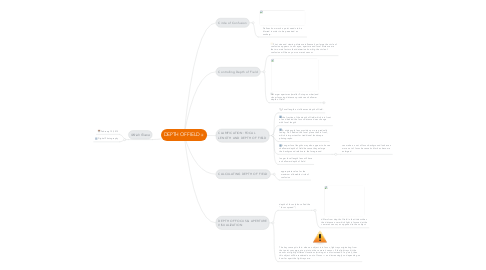DEPTH OF FIELD
by Miriah Rivera


1. Circle of Confusion
1.1. Defines how much a point needs to be blurred in order to be perceived as unsharp.
2. Controlling Depth of Field
2.1. Print size and viewing distance influence how large the circle of confusion appears to our eyes, aperture and focal distance are the two main factors that determine how big the circle of confusion will be on your camera's sensor.
2.2. Larger apertures (smaller F-stop number) and closer focusing distances produce a shallower depth of field.
2.2.1. Find examples
2.2.2. Find relevant quotes
2.2.3. References
2.2.3.1. Books
2.2.3.2. News sources
2.2.3.3. Blogs
2.2.3.4. Supporting Data
2.2.3.4.1. Expert reports
2.2.3.4.2. Third party research
2.2.3.4.3. Survey data
2.2.3.4.4. Size of topic
3. CLARIFICATION: FOCAL LENGTH AND DEPTH OF FIELD
3.1. Focal length as influences depth of field.
3.2. the fraction of the depth of field which is in front of and behind the focus distance does change with focal length
3.3. A wide angle lens provides a more gradually fading DoF behind the focal plane than in front, which is important for traditional landscape photographs.
3.4. Longer focal lengths may also appear to have a shallower depth of field because they enlarge the background relative to the foreground
3.4.1. can make an out of focus background look even more out of focus because its blur has become enlarged
3.5. longer focal length lens will have a shallower depth of field
4. CALCULATING DEPTH OF FIELD
4.1. appropriate value for the maximum allowable circle of confusion
5. Miriah Rivera
5.1. February 12,2013
5.2. Digital Photography
6. DEPTH OF FOCUS & APERTURE VISUALIZATION
6.1. depth of focus (also called the "focus spread")
6.1.1. differs from depth of field in that it describes the distance over which light is focused at the camera's sensor, as opposed to the subject:
